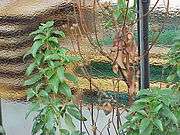Cistus laurifolius
Cistus laurifolius, commonly called laurel-leaf cistus,[1] laurel-leaved cistus[2] or laurel-leaved rock rose, is a species of highly branched flowering evergreen shrub native to some areas around the Mediterranean. It grows 0.8–2 m (2 ft 7 in–6 ft 7 in) high. The branches are strong and erect, with reddish bark that is easily removed in strips. The leaves are larger than in the other species of Cistus, up to 9 cm (4 in) long, lanceolate, dark green, while the underside is whitish due to trichomes. The flowering occurs in late spring (May–June), later than most rockroses.[3] It bears white flowers with a yellow spot in each petal, of 4.5–5 cm diameter[4] It is widely cultivated in gardens, and has gained the Royal Horticultural Society's Award of Garden Merit.[5]
Distribution and habitat
Cistus laurifolius has a disjunct natural distribution, in the Western Mediterranean area (Morocco, Portugal, Spain, southern France, Corsica and Tuscany), the Aegean and Anatolia.[4]
With the general warming of the atmosphere and the consequent withdrawal of the ice, flora surviving from Tertiary times could not re-establish their range in southern Europe; the new post-glacial climate was drier than that of the Tertiary. The original tropical European flora evolved into the present Mediterranean sclerophyll flora.[6][7][8] The distribution of some surviving species, such as Cistus laurifolius, moved to wetter areas such as the mountains.[8] Due to this, C. laurifolius is named in Spanish in its distribution area as "mountain rockrose",[8] although in the coastal west and northwest Iberian Peninsula, it is found at sea level.[9]
Cistus shrubland, including C. laurifolius, survives fire and has seeds that germinate after fire.[10]
Gallery
| Different vegetative and reproductive stages of Cistus laurifolius |
|---|
| Laurel-leaf cistus in its ecosystem. |
| General view of the shrub. |
| Young branches with the large leaves. |
| The fruits are capsules, with dehiscence revealing seeds within. |
|
Subtaxa
- Cistus laurifolius var. atlanticus Pit.[11]
- Cistus laurifolius var. lanceolatus Rouy & Foucaud
- Cistus laurifolius var. laurifolius
- Cistus laurifolius var. ovatus Rouy & Foucaud
References
External links

